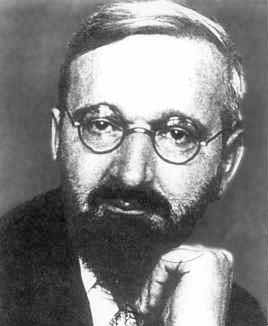
Theodor Franz Eduard Kaluza
 المؤلف:
V V Raman
المؤلف:
V V Raman
 المصدر:
Biography in Dictionary of Scientific Biography
المصدر:
Biography in Dictionary of Scientific Biography
 الجزء والصفحة:
...
الجزء والصفحة:
...
 16-6-2017
16-6-2017
 1327
1327
Born: 9 November 1885 in Opeln, Germany (now Opole, Poland)
Died: 19 January 1954 in Göttingen, Germany

Theodor Kaluza's father was Max Kaluza. He belonged to a family which had lived in Ratibor (now Raciborz in Poland) for around 300 years. Max Kaluza was a fine scholar and, although German, he was a leading expert on the English language and English literature, with his special field being the study of Chaucer. Theodor, who was an only child, showed great promise at school and he entered the University of Königsberg to study mathematics.
Kaluza continued his studies at Königsberg working towards his doctorate under Meyer's supervision. His habilitation thesis was on Tschirnhaus transformations and it was published in the Archiv der Mathematik und Physik in 1910. He had been examined and received the right to lecture in universities in theprevious year. Kaluza married in 1909 and, after his habilitation, became a Privatdozent at the University of Königsberg, a position which left him with hardly any income. Most academics are promoted after a few years as a Privatdozent, but Kaluza clearly was not thought to be of sufficient merit for he remained a Privatdozent for 20 years. One person who thought very highly of Kaluza, however, was Einstein.
He was teaching at Königsberg in April 1919 when he wrote to Einstein and told him about his ideas to unify Einstein's theory of gravity and Maxwell's theory of light. Einstein encouraged him to publish his highly original ideas which he did in 1921 in his paper on the unity problem of physics - Zum Unitätsproblem der Physik published in Sitzungsberichte Preussische Akademie der Wissenschaften 96 (1921), 69. It was Einstein who communicated the paper on 8 December 1921.
Kaluza's ideas involved the introduction of a fifth dimension and, although he has been criticised for introducing this as a purely mathematical idea, his work is important and was explored by others. He says in this paper that his theory possessed:-
... virtually unsurpassed formal unity ... which could not amount to the mere alluring play of a capricious accident.
The unifying feature of this theory was that it unified Einstein's theory of gravitation and Maxwell's electromagnetic theory. As Kaku writes in [3]:-
... this unknown scientist was proposing to combine, in one stroke, the two greatest field theories known to science, Maxwell's and Einstein's, by mixing them in the fifth dimension.
Kaluza is remembered for this in Kaluza-Klein (named after the mathematician Oskar Klein) field theory, which involved field equations in five-dimensional space. The theory, initially a popular topic of research, quickly lost favour with the introduction of quantum mechanics.
In November 1926 Einstein wrote in support of Kaluza to try to impress upon people that he was a mathematician who had produced a remarkably novel idea and was worth far more than the position of Privatdozent which he still occupied. Still Kaluza failed to gain promotion, then in 1929, exactly 20 years after being appointed a Privatdozent, he was appointed as professor in Kiel. In 1935 he was made a full professor at Göttingen where he remained until his death in 1954, two months before he was due to retire.
Perhaps Kaluza became too involved with his ideas in theoretical physics to make the contributions to mathematics which he was clearly capable of making. He continued to produce ideas relating to models of the atomic nucleus, and he wrote on relativity. Perhaps his finest mathematical work is the textbookHöhere Mathematik für die Pracktiker which was written jointly with G Joos and published in 1938. Raman writes [1]:-
in this work he showed himself as a mathematician rather than as a mathematical physicist.
His son, also named Theodor Kaluza, contributed personal details of his father which were incorporated into [1]. These give us feeling for Kaluza's character as:-
... a man of wide-ranging interests. Although mathematical abstraction delighted him tremendously, he was also deeply interested in languages, literature, and philosophy. He studied more than fifteen languages, including Hebrew, Hungarian, Arabic, and Lithuanian. He had a keen sense of humour. A nonswimmer, he once demonstrated the power of theoretical knowledge by reading a book on swimming, then swimming successfully on his first attempt (he was over thirty when he performed this feat). Kaluza loved nature as well as science and was also fond of children.
- V V Raman, Biography in Dictionary of Scientific Biography (New York 1970-1990).
http://www.encyclopedia.com/doc/1G2-2830902248.html
Books:
- P G Bergmann, An introduction to the Theory of Relativity (New York, 1942).
- V P Vizgin, Unified field theories in the first third of the twentieth century (Russian), 'Nauka' (Moscow, 1985).
- Yu S Vladimirov, Space-time : explicit and hidden dimensions (Russian), 'Nauka' (Moscow, 1989).
Articles:
- M Kaku, Hyperspace : A scientific odessey through parallel universes, time warps, and the 10th dimension (Oxford, 1994), 99-107.
- E Schmutzer, Weiterer Fortschritt der Physik durch Zuflucht in höhere Dimensionen?, Wiss. Z. Pädagog. Hochsch. Erfurt/Mühlhausen Math.-Natur. Reihe 24 (2) (1988), 10-20.
 الاكثر قراءة في 1885to1889
الاكثر قراءة في 1885to1889
 اخر الاخبار
اخر الاخبار
اخبار العتبة العباسية المقدسة


